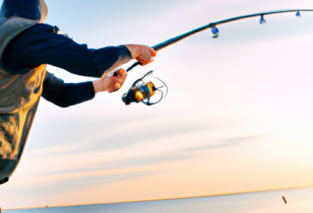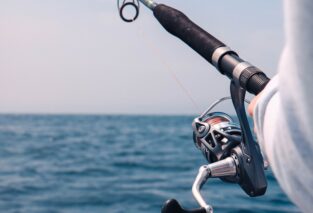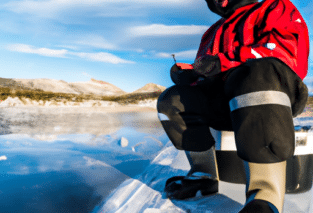If you’ve ever wondered whether you have what it takes to try your hand at fly fishing, look no further. “Can You Go Fly Fishing: Tips And Techniques For Fly Anglers” is here to guide you through the art of this peaceful and rewarding sport. Packed with valuable tips and expert techniques, this comprehensive guide will equip you with the knowledge and skills you need to embark on your fly fishing journey with confidence. Whether you’re a seasoned angler or a complete beginner, this book will help you navigate the intricacies of fly fishing and explore its myriad possibilities. Get ready to cast your line and discover the joys of fly fishing like never before.

Gear and Equipment
Fly Rods
When it comes to fly fishing, choosing the right fly rod is crucial. Fly rods are typically made from materials like graphite and fiberglass, with each material offering its own benefits. Graphite rods are lightweight and provide excellent sensitivity, while fiberglass rods offer a more traditional feel. It’s important to consider factors like rod weight, length, and action when selecting a fly rod, as these characteristics will affect your casting ability and overall fishing experience.
Fly Reels
The fly reel is another essential component of your fly fishing setup. The reel is responsible for holding and retrieving your fly line, as well as providing drag when you hook a fish. When choosing a fly reel, it’s important to consider factors like the reel’s weight, capacity, and drag system. A good fly reel should be durable, reliable, and able to handle the fish species you’re targeting.
Fly Lines
Fly lines are specifically designed to be cast with a fly rod and play a crucial role in the casting process. There are different types of fly lines available, such as floating lines, sinking lines, and sinking-tip lines. Your choice of fly line will depend on the fishing conditions and the types of flies you’ll be using. It’s also important to match the weight of your fly line to the weight of your fly rod for optimal performance.
Leaders and Tippets
Leaders and tippets are used to connect your fly line to your fly and provide a gradual transition from the thick fly line to the thin fly. They are typically made of monofilament or fluorocarbon material and come in various lengths and thicknesses. The leader and tippet combination is crucial for presenting your fly naturally to the fish and achieving a successful hookup.
Fly Selection
Choosing the right fly can make all the difference in fly fishing success. Flies come in various sizes, shapes, and colors, imitating different insects or baitfish. It’s important to consider the water conditions, time of day, and the type of fish you’re targeting when selecting flies. It’s also helpful to understand the basics of matching the hatch, imitating trout’s prey, and using attractors vs. imitators.
Waders and Boots
If you plan on fishing in rivers, lakes, or other bodies of water, investing in a good pair of waders and boots is essential. Waders are waterproof pants that allow you to wade into the water while keeping you dry. Boots provide traction and support, ensuring you can safely navigate slippery or rocky riverbeds. When choosing waders and boots, consider factors like durability, fit, and insulation depending on the weather conditions.
Fishing Vest or Pack
To keep your gear organized and easily accessible while on the water, consider investing in a fishing vest or pack. Fishing vests offer plenty of pockets and compartments to store your flies, leaders, tippets, and other essential tools. Fishing packs provide a larger storage capacity and often come with additional features like hydration systems. Choose a vest or pack that suits your needs and preferences for comfort and convenience.
Other Essential Tools
In addition to the basic gear and equipment mentioned above, there are several other essential tools that every fly angler should have. These include a landing net for safely landing and releasing fish, fly boxes for organizing and storing your flies, forceps or hemostats for removing hooks, and a good pair of polarized sunglasses to protect your eyes from the sun’s glare and enhance your ability to spot fish. It’s also a good idea to carry a small fly fishing tackle box with extra tippets, leaders, and other miscellaneous items.
Casting Techniques
Basic Casting Principles
To become an effective fly angler, it’s important to master the basic casting principles. These principles include proper grip and stance, smooth acceleration, and timely stopping of the fly rod during the casting motion. It’s also important to maintain a straight line path and use the power of your wrist and forearm to generate casting distance and accuracy. Practicing these basic principles will improve your casting efficiency and help you achieve more accurate and controlled presentations.
Overhead Cast
The overhead cast is the most common and versatile casting technique used in fly fishing. It involves bringing the fly rod backward and then forward in a smooth and controlled motion, with the fly line rolling out behind and in front of you. This cast allows you to cast at varying distances and target fish in different water conditions. Mastering the overhead cast is essential for any fly angler, as it serves as the foundation for other casting techniques.
Roll Cast
The roll cast is a casting technique used when there is limited space behind you to perform a full overhead cast. It involves sweeping the fly rod in a semicircular motion and using the tension of the water to propel the fly line forward. The roll cast is particularly useful when fishing in tight quarters or dealing with obstacles like trees or brush. Practicing the roll cast will improve your ability to make accurate and efficient casts in challenging fishing scenarios.
Reach Cast
The reach cast is a casting technique used to present your fly in a more natural and drag-free manner. It involves making a straight-line cast followed by subtly reaching your rod tip upstream just before the fly line lands on the water. This action allows the fly to land first while the fly line follows, minimizing any drag that could spook the fish. The reach cast is especially effective when fishing in currents or presenting your fly to wary trout.
Double Haul Cast
The double haul cast is a more advanced casting technique that involves using both your rod hand and line hand to generate more line speed and casting distance. It requires timing and coordination, as you need to smoothly pull on the fly line with your line hand while simultaneously executing the casting motion with your rod hand. The double haul cast is particularly useful when fishing in windy conditions or when you need to reach distant targets.
Mending
Mending is a crucial technique used to control the drift of your fly on the water. It involves manipulating the fly line after it has landed on the water to eliminate drag and achieve a natural presentation. Mending can be done by making upstream or downstream movements with your rod tip or by using your line hand to adjust the position of the fly line. Mastering the art of mending will greatly improve your ability to present your fly effectively in different water currents.
False Casting
False casting is a casting technique used to extend line length, change casting direction, or dry off your fly before making a presentation. It involves making repeated forward and backward casting motions without allowing the fly to touch the water. False casting can be useful when you need to make precise casts or when you’re trying to entice a fish to take your fly. However, it’s important to avoid excessive false casting, as it can increase the risk of spooking fish or tangling your line.
Using the Wind to Your Advantage
Fly fishing in windy conditions can present its challenges, but it can also work to your advantage if you know how to use it to your benefit. A headwind can help you make longer casts and provide more accurate presentations, as the wind resistance can help straighten out your fly line. A tailwind, on the other hand, will require adjustments in your casting technique and the use of additional false casts to maintain control. By understanding how the wind affects your casting and adjusting your approach accordingly, you can effectively fish in various wind conditions.
Casting in Different Conditions
Different fishing conditions, such as varying water currents, wind speeds, and casting space, will require adjustments in your casting technique. It’s important to be adaptable and comfortable with different casting techniques so that you can effectively fish in a variety of scenarios. Practicing your casting skills in different conditions will improve your versatility as an angler and increase your chances of success on the water.

Understanding Flies and Insects
Types of Flies
There are numerous types of flies used in fly fishing, each imitating a specific food source for fish. Dry flies are designed to float on the surface of the water and mimic insects like mayflies, caddisflies, and stoneflies. Nymphs are subsurface flies that imitate immature aquatic insects, such as mayfly nymphs and caddisfly larvae. Streamers are larger, more colorful flies that imitate baitfish or leeches. Understanding the different types of flies and their purposes will help you choose the right fly for the specific fishing situation and increase your chances of attracting fish.
Matching the Hatch
Matching the hatch refers to selecting a fly pattern that closely resembles the insects currently hatching on the water. When fish are actively feeding on a specific insect species, presenting a fly that closely imitates that insect can greatly increase your chances of success. This technique requires observation and knowledge of local insect hatches, as well as having a variety of fly patterns that mimic different stages of insect development. Matching the hatch is a crucial skill for any fly angler looking to fool selective trout and other fish species.
Imitating Trout’s Prey
Trout are opportunistic feeders and will gorge themselves on a variety of aquatic and terrestrial insects. Understanding the specific prey items that trout feed on in your local fishing waters will help you choose the appropriate fly patterns to imitate their preferred meals. Common trout prey includes mayflies, caddisflies, stoneflies, midges, scuds, and terrestrials like beetles and grasshoppers. By presenting flies that mimic these prey items, you can trigger a response from hungry trout and increase your chances of hooking into a fish.
Aquatic Insects
Aquatic insects play a significant role in a fish’s diet, especially in freshwater systems. These insects include mayflies, caddisflies, stoneflies, midges, and damselflies, among others. Understanding the life cycles and behaviors of these insects is important for fly anglers, as it helps them choose the right fly patterns and present them in a manner that appears natural to the fish. Aquatic insects have distinct characteristics and habits that influence when and where fish are likely to feed on them, so having knowledge of these insects can greatly enhance your fishing experience.
Terrestrial Insects
Terrestrial insects are those that reside primarily on land but often find themselves in the water, becoming a food source for fish. Popular terrestrial insects used in fly fishing include beetles, ants, and grasshoppers. These insects are readily available to fish during specific seasons and can create exciting feeding opportunities. Understanding when and how terrestrials fall into the water and how fish respond to their presence will help you select appropriate fly patterns and techniques to imitate these insects effectively.
Understanding Life Cycles
Insects go through different life stages, and each stage presents fly anglers with unique fishing opportunities. From nymphs and larvae to emergers and adults, insects experience various transformations as part of their life cycle. Understanding these life stages and their corresponding behavioral patterns will help you choose the right fly patterns and fishing techniques that match the specific stage of the insect. By presenting the appropriate fly at the right time, you can increase your chances of success and fool fish into taking your fly.
Fly Sizes and Patterns
The size and pattern of your fly can significantly impact your success on the water. Fly sizes typically range from larger streamers to tiny midges, with the size of the fly depending on the specific insects or baitfish you’re imitating. It’s important to have a variety of fly sizes and patterns in your arsenal, as fish can be selective and prefer certain sizes or colors at different times. Having options and experimenting with different sizes and patterns will help you determine what’s working best on any given day.
Attractors vs. Imitators
When it comes to fly selection, you have the option to choose between attractor flies and imitator flies. Attractor flies are brightly colored, flashy patterns that don’t necessarily imitate any specific food source but instead provoke a response from fish due to their stimulation. These flies can be effective in situations where fish are aggressive or when fishing in stained or fast-moving water. Imitator flies, on the other hand, closely resemble specific insects or baitfish and aim to fool fish into thinking they are real food. Knowing when to use attractors or imitators will depend on the fishing conditions and the behavior of the fish you’re targeting.
Reading the Water
Identifying Prime Spots
To increase your chances of finding fish, it’s essential to learn how to identify prime spots within a body of water. Prime spots are areas where fish are likely to hold and feed, such as deep pools, riffles, runs, and eddies. These spots provide fish with refuge, oxygen, and access to food. Look for features like structure, cover, and changes in water depth and temperature to identify prime spots. By targeting these areas, you can focus your fishing efforts and maximize your chances of hooking into a fish.
Currents and Eddies
Understanding water currents and eddies is crucial for successful fly fishing. Currents play a significant role in how fish position themselves in the water, as they provide a source of food and oxygen. Eddies, which are circular currents, often form behind rocks, logs, or other obstructions and create ideal feeding zones for fish. By observing and understanding the flow of water, you can identify productive areas where fish are likely to be holding and target your presentations accordingly.
Pools, Riffles, and Runs
Pools, riffles, and runs are three main types of water within a river or stream and each offers its own fishing opportunities. Pools are deeper, slower-moving areas where fish tend to hold in search of food and protection. Riffles are shallow, fast-moving stretches of water where fish will often feed on insects or seek refuge from predators. Runs are transitional areas between pools and riffles and provide a mix of slower and faster currents. By understanding the characteristics of each type of water, you can adapt your fishing strategies and presentations accordingly.
Obstructions and Pockets
Obstructions, like fallen trees or large rocks, create pockets of slower-moving water where fish often seek refuge and feed. These pockets offer a break from the main current and can be prime spots to target when fly fishing. The eddies and calm water created by these obstructions provide fish with easier access to food and shelter. By presenting your fly accurately in these pockets and working it through the slower water, you can entice fish to strike.
Structure and Cover
Fish seek structure and cover for protection from predators and as staging areas for feeding. Structure can include features like rocks, submerged logs, or undercut banks, while cover can be vegetation, overhanging branches, or areas of dense structure. By casting near or around structure and cover, you increase your chances of finding actively feeding fish. These areas provide fish with a level of security, and presenting your fly close to these features can trigger a strike.
Depth and Temperature
The depth and temperature of the water play important roles in fish behavior and feeding patterns. Fish will often inhabit different depth ranges depending on factors like water temperature, oxygen levels, and the availability of food. Understanding the preferred depth ranges for the fish species you’re targeting will help you determine where to present your fly and at what depth. Water temperature can also influence fish activity, with certain species becoming more active during warmer or cooler temperatures. Monitoring water temperature and adjusting your fishing strategies accordingly can greatly improve your chances of success.

Presentation Techniques
Dead Drift
The dead drift presentation is a technique used to present your fly in a natural and drag-free manner. It involves casting your fly upstream and allowing it to drift naturally downstream with the current, mimicking the behavior of a drifting insect. To achieve a successful dead drift, it’s important to mend your fly line to eliminate any drag and maintain a natural drift. This presentation is particularly effective when fishing with dry flies, nymphs, or emergers in situations where fish are selectively feeding on insects.
Swinging Flies
Swinging flies is a presentation technique commonly used when fishing with streamers or wet flies. It involves casting your fly across the current and allowing it to swing across the water as it’s retrieved downstream. This technique imitates the movement of a wounded or fleeing baitfish, triggering aggressive strikes from predatory fish. The speed of the swing can vary depending on the target species and water conditions, so it’s important to experiment with different retrieval speeds to find what works best.
Nymphing
Nymphing is a popular technique used to target fish feeding below the water’s surface. It involves using weighted nymph flies and additional weight (such as split shot) to get your flies down to the desired depth. Nymphs are then presented by drifting them naturally with the current, either with an indicator or without. Nymphing can be an effective technique for catching trout and other species, as insects in their nymphal stage are readily available and represent a significant portion of a fish’s diet.
Dry Fly Fishing
Dry fly fishing is often considered the epitome of fly fishing, as it involves presenting a fly on the water’s surface, imitating insects that have hatched or fallen on the water. This technique is highly visual and offers the excitement of witnessing fish rise to take a fly. It requires careful observation of insect activity and precise presentation of the fly to match the naturals. Dry fly fishing is all about fooling fish into thinking your artificial fly is the real thing, and it can provide thrilling and memorable experiences on the water.
Streamer Fishing
Streamer fishing is a technique used to imitate baitfish or other large food sources for predatory fish. Streamers are typically larger and more colorful flies that are stripped or retrieved through the water. This presentation is meant to provoke an aggressive response from fish, triggering strikes. It’s important to vary your retrieval speed, depth, and pattern selection when streamer fishing to determine what the fish are responding to. Streamer fishing can be particularly effective when targeting larger fish or when fish are in a predatory mood.
Presentation Methods in Different Situations
The presentation techniques mentioned above can be adapted and combined depending on the fishing situation and the behavior of the fish. Each situation may require a different approach, such as when fish are holding in deep pools or when they’re selectively feeding on a specific insect. It’s important to be flexible and willing to experiment with different techniques to find what works best. Adapting your presentations based on water conditions, fish behavior, and the specific flies you’re using will greatly enhance your success as a fly angler.
Understanding Fish Behavior
Trout Behavior
Trout are one of the most sought-after fish species in fly fishing, and understanding their behavior is key to successful angling. Trout are selective feeders and have a keen eye for detail, often requiring a precise presentation to fool them into taking a fly. They tend to hold in spots with cover, structure, and access to food, and detecting their presence can be challenging. Learning their preferred habitat, feeding patterns, and behavior in different seasons will greatly improve your chances of finding and catching trout.
Feeding Habits
Trout have a varied diet and will feed on a wide range of insects, baitfish, and other food sources. Their feeding habits can vary depending on the specific trout species, water conditions, and the time of year. Understanding the feeding habits of trout will help you select the right fly patterns and present them in a way that entices the fish to strike. Pay attention to the time of day, water temperature, and the behavior of the fish to determine when and how they’re feeding.
Seasonal Patterns
Trout behavior can also vary throughout the different seasons, influencing their feeding patterns and preferred habitat. In the spring, trout may be more active and aggressive, feeding on emerging insects and baitfish. In the summer, trout may seek cooler water temperatures and hold in deeper pools or behind large rocks. Fall can bring increased feeding activity as trout prepare for the winter months. By understanding the seasonal patterns of trout in your local fishing waters, you can adjust your strategies and techniques for optimal success.
Reading Rise Forms
Rise forms are the visible disturbances created by fish as they feed on the water’s surface. Reading rise forms can provide valuable clues about the types of insects or food sources trout are feeding on and their feeding behavior. Different rise forms, such as gentle sips, splashy rises, or tail flicks, can indicate specific feeding patterns. Observing and interpreting rise forms will help you determine which flies to use, how to present them, and where to target your casts.
Approach and Stealth
Trout, and many other fish species, have a keen sense of hearing and can be easily spooked by approaching anglers. Approach the water slowly and quietly, avoiding sudden movements or disturbances that could alert the fish to your presence. Wear neutral-colored clothing and use caution when walking on the banks to minimize vibrations. Maintaining a low profile and being stealthy will increase your chances of getting close to fish without alarming them, allowing for more successful presentations.
Playing and Landing Fish
Once you’ve hooked a fish, it’s essential to know how to properly play and land it to ensure its safe release. Fighting a fish involves maintaining tension on the line while allowing it to run and tire itself out. Use the flexibility of your fly rod and the drag on your reel to control the fish’s movements and prevent it from breaking off. When it’s time to land the fish, take care not to handle it excessively or remove it from the water for too long. Wet your hands before handling the fish, support it gently, and release it as quickly as possible to ensure its survival.
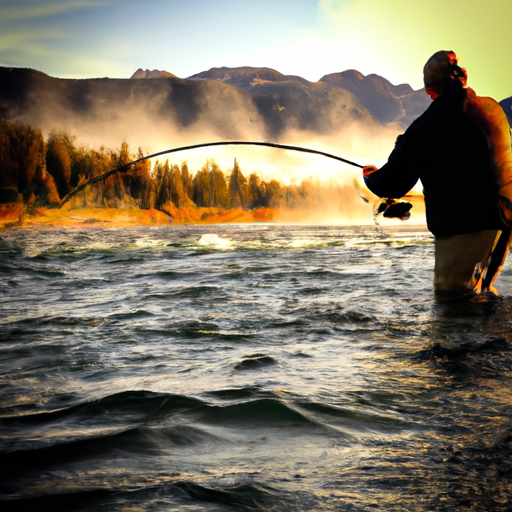
Knot Tying and Rigging
Basic Knots for Fly Fishing
Learning and mastering a few basic knots is crucial for fly fishing. The improved clinch knot is widely used for attaching flies to tippet or leader material. The surgeon’s knot is commonly used for joining two pieces of leader or tippet together. The nail knot is used to attach the leader to the fly line, and the loop-to-loop connection is used to join different sections of line or leader together. Practicing these knots until you can tie them confidently and efficiently will save you time on the water and ensure that your connections are secure.
Attaching Fly to Tippet
Attaching your fly to the tippet requires a strong and secure knot. The improved clinch knot is a popular choice for this purpose. To tie the improved clinch knot, pass the tippet through the eye of the fly, then make five to seven wraps around the standing line. Pass the end of the tippet through the small loop that was formed above the eye of the fly, then wet the knot and tighten it by pulling on the standing line and the tag end simultaneously. Trim the excess tippet, leaving a small tag end for added strength.
Tying Leader to Fly Line
The nail knot is commonly used to attach the leader to the fly line. To tie the nail knot, find a small-diameter tube or nail that is slightly larger in diameter than the fly line. Insert the end of the fly line into the tube, leaving a few inches of excess line extending beyond the tube. Make several wraps with the leader material around the fly line and the tube, leaving a small loop. Pass the end of the leader material through the loop, then remove the tube. Wet the knot and slide it tight against the end of the fly line. Trim the excess leader material.
Building Leaders
Building leaders involves assembling different sections of monofilament or fluorocarbon material to create a tapering leader. A typical leader consists of a butt section, a mid-section, and a tippet section. The butt section is thicker and attached to the fly line, while the tippet section is thinner and attached to the fly. The mid-section serves as a transitional link between the two. Leaders can be constructed using various formulas and lengths, depending on personal preference and fishing conditions. Building your leaders allows for customization and ensures that you have the appropriate taper and strength for the type of fishing you’ll be doing.
Using Indicators
Indicators, also known as strike indicators or bobbers, are used to detect subtle strikes when nymph fishing. Indicators are typically made of buoyant materials like foam, plastic, or yarn and are attached to the leader above the nymphs. They help anglers visualize when a fish has taken the fly by pausing, twitching, or submerging. Indicators can be adjusted for different water depths and fishing conditions by adding or removing weight or adjusting the leader length. Using indicators effectively can greatly enhance your ability to detect strikes and increase your chances of hooking into fish.
Adding Weight to Your Rig
Adding weight to your rig is necessary when fishing subsurface flies or when you want to achieve a specific depth. Split shot or weighted flies can be added above or below your fly to get it down to the desired level. The amount of weight you add will depend on the water depth, current speed, and the specific flies you’re using. It’s important to distribute the weight evenly along the leader to maintain a balanced presentation and prevent your fly from sinking too quickly or unnaturally. Experimenting with different amounts and placements of weight will help you achieve the desired presentation and effectively fish at different depths.
Effective Fly Fishing Strategies
Locating Fish
Locating fish is a crucial part of fly fishing success. Observing the water for rising fish, surface activity, or other signs of fish presence can provide valuable information about where to target your casts. Look for areas with structure, cover, or changes in the current where fish are likely to hold or feed. Polarized sunglasses can help you see into the water, allowing you to spot fish or any visual cues that indicate their presence. By actively searching for fish and adjusting your fishing strategies accordingly, you can increase your chances of finding and hooking into fish.
Using Streamers to Attract Large Fish
Streamers are particularly effective for targeting larger fish, as they imitate baitfish or other large food sources. When using streamers, it’s important to vary your retrieval speed, depth, and pattern selection to find what triggers a response from the fish. Experiment with different retrieves, such as a slow strip, fast strip, or erratic retrieval, to mimic the movement of a wounded or fleeing baitfish. It’s also helpful to target areas where larger fish are likely to hold, such as deep pools, undercut banks, or the edges of drop-offs. By presenting streamers effectively, you can entice larger fish to strike and experience thrilling takes.
Targeting Specific Areas
Having a targeted approach to your fishing can significantly increase your chances of success. By focusing on specific areas within a body of water, such as prime spots or areas with visible fish activity, you can increase your efficiency and effectiveness. Rather than randomly casting your fly, take the time to observe the water, identify potential fish-holding areas, and strategize your approach. By concentrating your efforts on these specific areas, you can maximize your chances of encountering active and feeding fish.
Matching the Water Conditions
Water conditions, such as temperature, clarity, and flow rate, can greatly influence fish behavior and feeding patterns. Observing and understanding these conditions will help you select the appropriate flies, adjust your presentations, and choose the most effective fishing strategies. For example, in warmer water temperatures, fish may be more active and willing to chase streamers or larger flies. In clear water, fish may be more selective and require a more delicate presentation with smaller or more realistic flies. By considering the water conditions and adapting your approach accordingly, you can increase your chances of fooling fish into taking your fly.
Testing Different Techniques
Fly fishing is a lifelong learning process, and trying out different techniques is a key part of becoming a more successful angler. Don’t be afraid to experiment with different casting techniques, retrieve speeds, or presentation methods to see what works best in different situations. If one technique isn’t producing results, be willing to switch things up and try something new. By constantly challenging yourself and testing different techniques, you’ll develop a versatile skill set and improve your ability to adapt to changing fishing conditions.
Adapting to Changing Circumstances
Fly fishing is a dynamic activity, and conditions on the water can change throughout the day. Being adaptable and willing to adjust your approach is crucial for consistent success. Keep an eye on the weather, water conditions, and fish behavior, and be prepared to make changes as necessary. This might involve changing fly patterns, adjusting your presentation, trying different fishing spots, or even switching to a different fishing technique altogether. By staying flexible and adapting to changing circumstances, you can optimize your fishing experience and increase your chances of hooking into fish.
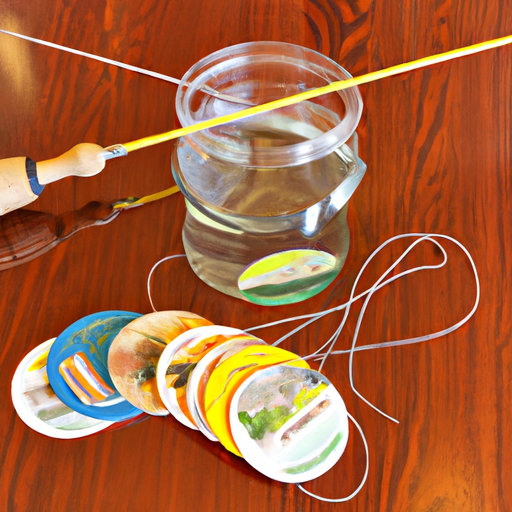
Safety and Conservation Measures
Personal Safety
Personal safety should always be a top priority when fly fishing. Be mindful of your surroundings and potential hazards, such as slippery rocks, swift currents, or deep water. Wearing appropriate footwear, like wading boots with felt or rubber soles, can provide traction and prevent slips and falls. It’s also essential to wear a personal flotation device (PFD) when wading in deeper water or boating. Additionally, protect yourself from the sun by wearing sunscreen, protective clothing, and a hat. By practicing personal safety measures, you can minimize the risk of accidents or injuries while enjoying your time on the water.
Ethical Fishing Practices
Ethical fishing practices involve respecting the fish, the environment, and other anglers. This includes following fishing regulations, practicing catch and release, and being considerate of other anglers’ space and fishing opportunities. Handle fish with care, keeping them in the water as much as possible, and using catch and release techniques that minimize harm and stress. Be responsible with your fishing equipment and avoid leaving any trash or debris behind. By adopting ethical fishing practices, you can help preserve fish populations, maintain healthy ecosystems, and ensure a positive fishing experience for everyone.
Catch and Release Techniques
Catch and release is a common practice among fly anglers, allowing fish to be returned to the water unharmed after being caught. It’s important to handle fish with care and use proper techniques to minimize stress and potential injury. Wet your hands before handling the fish to protect their delicate slime coating and avoid removing them from the water for extended periods. Use barbless hooks or flatten the barbs on your flies to make hook removal easier and safer. Avoid squeezing or gripping the fish tightly, as this can cause internal injuries. By following catch and release guidelines, you can enjoy the thrill of catching fish while ensuring their survival for future generations.
Preserving Fish Habitats
Preserving fish habitats is crucial for maintaining healthy fish populations and productive fisheries. Be cautious when wading to avoid damaging sensitive aquatic vegetation or disturbing fish redds (nests). Avoid fishing in areas closed for habitat conservation or spawning seasons. Dispose of trash properly and participate in river clean-up initiatives to help keep waterways clean and free from pollutants. Respect riparian zones by avoiding trampling on streamside vegetation and refraining from disturbing nesting birds or other wildlife. By practicing habitat preservation, you can contribute to the long-term health of fish populations and the ecosystems they inhabit.
Respecting Wildlife and Other Anglers
Respecting wildlife and other anglers is important for creating a positive fishing experience and fostering a sense of camaraderie within the angling community. Give wildlife, such as birds, mammals, and reptiles, a wide berth and avoid disturbing their natural behaviors or habitats. Be considerate of other anglers by giving them ample space and refraining from casting over their lines. Observe fishing etiquette, such as taking turns in popular fishing spots and practicing good sportsmanship. By showing respect for wildlife and other anglers, you contribute to the conservation of natural resources and promote a harmonious fishing environment.
Resources and Further Learning
Books and Magazines
There are numerous books and magazines available that provide valuable information and insights into the world of fly fishing. These resources cover various topics, including fly tying, casting techniques, entomology, fish behavior, and specific fishing destinations. Look for titles by renowned authors such as Lefty Kreh, John Gierach, or Gary Borger. Fly fishing magazines like “Fly Fisherman,” “Trout,” and “The Drake” offer a wealth of articles, interviews, and stunning photography to inspire and educate fly anglers of all levels.
Online Tutorials and Courses
The internet provides a wealth of online tutorials and courses that cater to both beginner and advanced fly anglers. Websites like YouTube offer a vast library of videos demonstrating casting techniques, fly tying instructions, and fishing tips from seasoned anglers. Online fly fishing schools, such as Orvis and Trout Unlimited, offer comprehensive courses covering a range of topics, including casting, fly tying, and specific fishing techniques. These resources provide a convenient and accessible way to improve your skills and expand your knowledge from the comfort of your own home.
Joining Fly Fishing Communities
Joining fly fishing communities, whether online or in person, is an excellent way to connect with fellow anglers, share experiences, and gain insights. Online forums and social media groups dedicated to fly fishing provide opportunities to ask questions, seek advice, and engage in discussions with like-minded individuals. Local fly fishing clubs and organizations offer the chance to participate in outings, workshops, and events where you can learn from experienced anglers and build connections within the fly fishing community. Being part of a fly fishing community allows you to stay informed, learn from others, and foster friendships that can enhance your fly fishing journey.
Gaining Local Knowledge
Nothing beats local knowledge when it comes to fly fishing success. Learning about the specific waters you’ll be fishing, including river systems, lakes, and their respective fish species, can significantly improve your chances of catching fish. Local fly shops are invaluable sources of information, offering insights into local hatches, fishing conditions, and effective fly patterns. Strike up conversations with local anglers, river guides, or members of fishing organizations to tap into their knowledge and gain valuable tips. By acquiring local knowledge, you’ll be better equipped to navigate the waters and adjust your strategies for optimal success.
Attending Workshops and Events
Attending workshops and events dedicated to fly fishing is a fantastic way to learn from experts, gain hands-on experience, and immerse yourself in the fly fishing community. Look for workshops that cover casting techniques, fly tying, entomology, and other topics relevant to your interests. Fly fishing expos and trade shows bring together industry professionals, manufacturers, and anglers from all over the world, providing opportunities to see the latest gear, attend seminars, and network with fellow fly anglers. These events offer a wealth of knowledge, inspiration, and camaraderie that can take your fly fishing skills to the next level.



